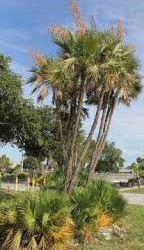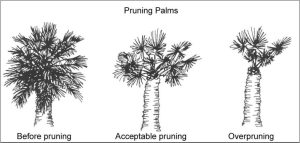Palms swaying in the breeze are typically associated with a tropical or subtropical climate but in the plant world, palms have a unique characteristic: because many of them grow with an elevated canopy similar to trees, in lay-terms, palms are usually regarded as trees, but in the strict botanic sense, palms are not classified as trees. Palms can also often have unique growth requirements, and those for the Paurotis palm are reviewed below.
 Planting site
Planting site
Paurotis palms have a clumping growth habit, with several trunks eventually emerging from the original planting spot, so they will need lots of room to spread out – typically 10 to 15 ft. wide. Paurotis palms also are unique in that they are one of the few palms which will tolerate intermittently flooded soils.
Nutrient requirements
Paurotis palms can become susceptible to manganese deficiency resulting in yellowing fronds. Click on these links for additional information on manganese deficiency and fertilizing palms.
Pests and diseases
Many of the pests and diseases that generally affect other palms e.g. palm aphids or Fusarium wilt, are typically not found on the Paurotis palm. Click these links to learn more about palm pests and diseases.
Pruning
Because palms have unique nutritional requirements and they tend to recycle many of their nutrients from older growth to newer growth, when pruning palms, green fronds should never be removed; pruning should be reserved for spent flower stalks, immature fruit, and brown fronds. Over-pruning palms can make them susceptible to nutrient deficiencies and pests and diseases. To learn more about pruning palms, click on this link.
 1
1

